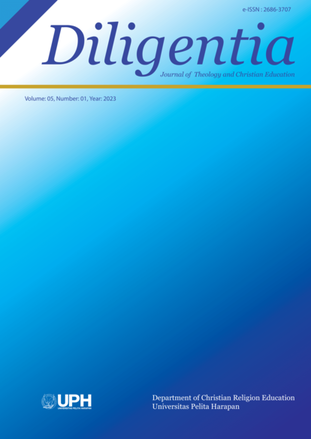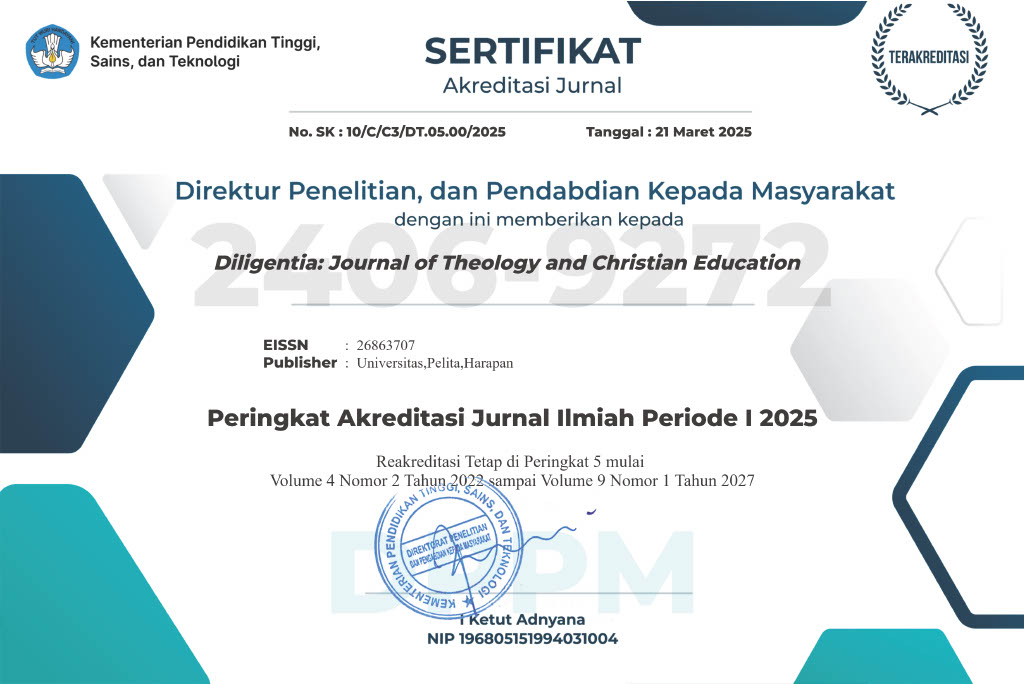Paskah Kristiani Menggenapi Kovenan Mesianik Dalam Kejadian 3:15 [The Christian Passover Fulfills the Messianic Covenant in Genesis 3:15]
DOI:
https://doi.org/10.19166/dil.v5i1.6494Kata Kunci:
Passover, covenant, messianic, fulfilment, paskah, perjanjian, mesianis, penggenapanAbstrak
Passover celebrations are always repeated every year for Christians, although not as festive as Christmas. Christian Passover events are a series of events from the death of Jesus Christ on the cross and His resurrection on the third day. There have been many attempts to reduce the events of the cross and deny the crucified figure of Jesus Christ. This research tries to explore and examine the meaning of Easter in Christianity and how it relates to the Messianic Covenant in Genesis 3:15. The method used is qualitative with a literature review approach, examining the red threads of the Old and New Testaments regarding Passover, where in the conclusion there is a relationship between Genesis 3:15 concerning the Messianic covenant as a type and its antitype or fulfilment is in the event of the cross, and this is a work God's salvation in overcoming human sin, on the one hand God's justice is satisfied by punishing sin on the cross, and on the other hand it shows God's love for humans. Thus, as people who believe in Jesus Christ, they must understand the meaning of this Passover in their daily lives, and moreover, theological high school students and church pastors must understand that and educate the congregation to maintain the spirit of Passover.
BAHASA INDONESIA ABSTRACT: Perayaan Paskah selalu berulang setiap tahun bagi umat Kristiani, meskipun tidak semeriah Natal. Peristiwa Paskah adalah suatu rangkaian peristiwa dari kematian Yesus Kristus di kayu salib dan kebangkitan-Nya pada hari yang ketiga. Banyak upaya untuk mereduksi peristiwa salib dan menafikan sosok Yesus Kristus yang tersalib. Penelitian ini mencoba menggali dan mengkaji makna paskah dalam kekristenan dan apa hubungannya dengan kovenan Mesianik dalam Kejadian 3:15. Metode yang dipergunakan adalah kualitatif dengan pendekatan kajian Pustaka, menelisik benang merah Perjanjian Lama dan Perjanjian Baru tentang Paskah, di mana dalam simpulan terdapat hubungan antara Kejadian 3:15 tentang kovenan Mesianik sebagai tipe dan antitipenya atau penggenapannya ada pada peristiwa salib, dan ini merupakan karya keselamatan Allah dalam mengatasi dosa manusia, di satu sisi keadilan Allah terpuaskan dengan menghukum dosa di salib, dan di sisi lainnya menunjukkan kasih Allah pada manusia. Dengan demikian sebagai umat yang percaya kepada Yesus Kristus harus memahami makna Paskah ini dalam kehidupan sehari-hari dan terlebih bagi mahasiswa Sekolah Tinggi Teologi dan para gembala gereja harus memahami itu dan mengedukasi jemaat untuk tetap menjaga semangat Paskah.
Referensi
Arrington, French L. Doktrin Kristen Perspektif Pentakosta. Yogyakarta, Indonesia: Penerbit Andi, 2020.
Bible Works. “Software Alkitab Version 7: LXX Septuaginta,” 2006.
Cassuto, Umberto. A Commentary on the Book of Exodus. Jerusalem: The Hebrew University Magnes Press, 1997.
Daeli, Regueli, Samuel Purdaryanto, and Apriani Telaumbanua. “Allah Telah Berjanji untuk Menyelamatkan Manusia: Sebuah Studi Eksegesis Kejadian 3:15.” Charistheo: Jurnal Teologi dan Pendidikan Agama Kristen 1, no. 2 (2022). https://doi.org/10.54592/jct.v1i2.16.
Douglas, J.D. Ensiklopedi Alkitab Masa Kini Jilid 1. Jakarta: Yayasan Komunikasi Bina Kasih, 1994.
Douglas, J.D. Ensiklopedi Alkitab Masa Kini Jilid II. Jakarta, Indonesia: Yayasan Komunikasi Bina Kasih, 1997.
Dufour, Xavier Leon. Ensiklopedia Perjanjian Baru. Yogyakarta, Indonesia: Penerbit Kanisius, 1991.
Dyrness, William. “Tema-Tema dalam Teologi Perjanjian Lama.” Malang, Indonesia: Gandum Mas (2004).
Gaebelein, Frank E. The Expositor’s Bible Commentary. Vol. 9. Grand Rapids, MI: Zondervan Publication, 1981.
Gavriel, Christopher Sean. “Pasover Atau Easter?” April 19, 2009. https://student-activity.binus.ac.id/po/tag/passover-atau-easter/.
Harefa, Yulius Enisman. “Karakteristik Kemesiasan Yesus,” Jurnal BMW-Go 1, no. 2 (2017). https://www.academia.edu/44918251/Karakteristik_Kemesiasan_Yesus.
Harris, W. Hall. “Teologi Dari Tulisan-Tulisan Yohanes.” In A Biblical Theology of The New Testament, edited by Roy B Zuck. Malang, Indonesia: Penerbit Gandum Mas, 2020.
Hunerwadel, Seth L. Habrit Hachadashah (The New Testament) 1 of 2. Monee, IL: Seth Hunerwadel, 2020.
Orthodox Jewish Bible. Yochanan 19:31.
Palealu, Janes. “Dampak Konteks Politik Masa Intertestamental pada Penolakan Yesus sebagai Mesias.” Angelion: Jurnal Teologi dan Pendidikan Kristen 3, no. 1 (2022). https://doi.org/10.38189/jan.v3i1.312.
Purba, Jhon Leonardo Presley, Hizkia Febrian Prastowo, and Robinson Rimun. “Kajian Hermeneutis Ungkapan ”˜Sungguh Amat Baik’ dalam Kejadian 1: 31 Ditinjau dari Perspektif Redemptive-Historical Approach.” Charistheo: Jurnal Teologi dan Pendidikan Agama Kristen 1, no. 2 (2022): 122-133. https://doi.org/10.54592/jct.v1i2.14.
Sutanto, Hasan. Perjanjian Baru Interlinear Yunani-Indonesia dan Konkordansi Perjanjian Baru (PBIK) Jilid II. Jakarta, Indonesia: Lembaga Alkitab Indonesia, 2019.
Tong, Stephen. 7 Perkataan Salib. Jakarta, Indonesia: Lembaga Reformed Injili Indonesia, 1995.
Wahyu, Rita. Eksegesis Peshat Kitab Kejadian. Malang, Indonesia: ISCS Publishing House, 2018.
Wahyu, Rita. Injil Salib Besorat Hatselav. Jakarta, Indonesia: Ekumene Literature, 2020.
Wiersbe, Warren W. The Wiersbe Bible Commentary: New Testament. Colorado Springs, CO: David C. Cook, 2007.
Unduhan
Diterbitkan
Cara Mengutip
Terbitan
Bagian
Lisensi
Authors who publish with this journal agree to the following terms:
1) Authors retain copyright and grant the journal right of first publication with the work simultaneously licensed under a Creative Commons Attribution License (CC-BY-SA 4.0) that allows others to share the work with an acknowledgement of the work's authorship and initial publication in this journal.
2) Authors are able to enter into separate, additional contractual arrangements for the non-exclusive distribution of the journal's published version of the work (e.g., post it to an institutional repository or publish it in a book), with an acknowledgement of its initial publication in this journal.
3) Authors are permitted and encouraged to post their work online (e.g., in institutional repositories or on their website). The final published PDF should be used and bibliographic details that credit the publication in this journal should be included














